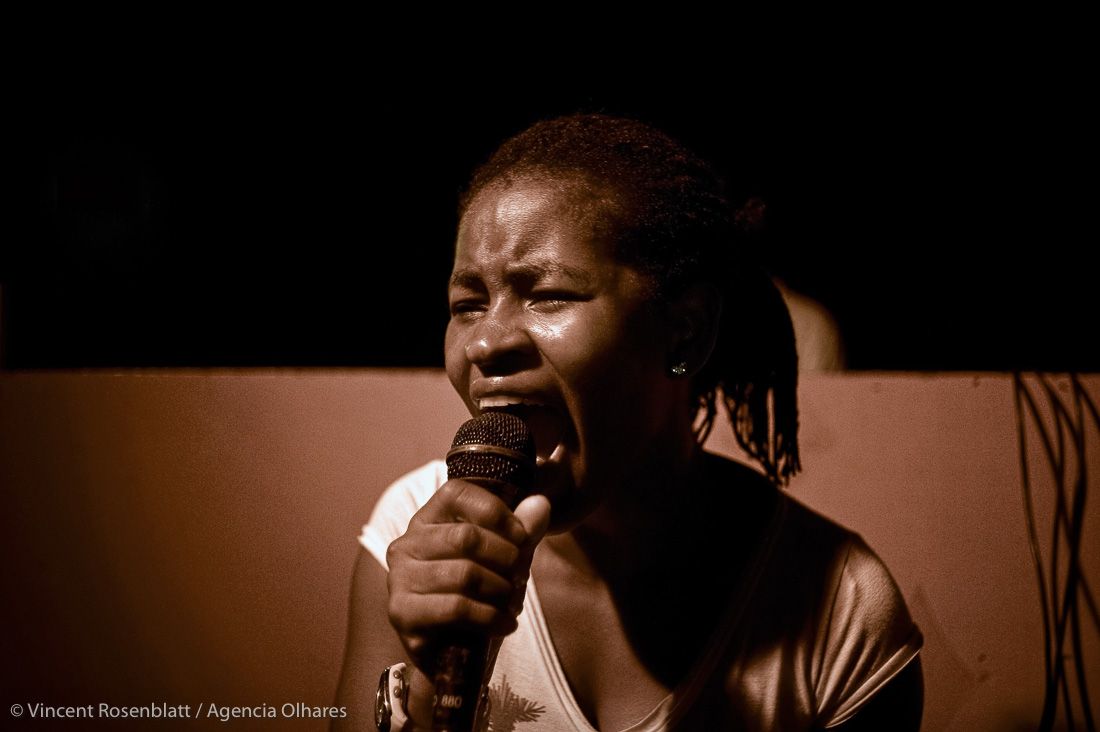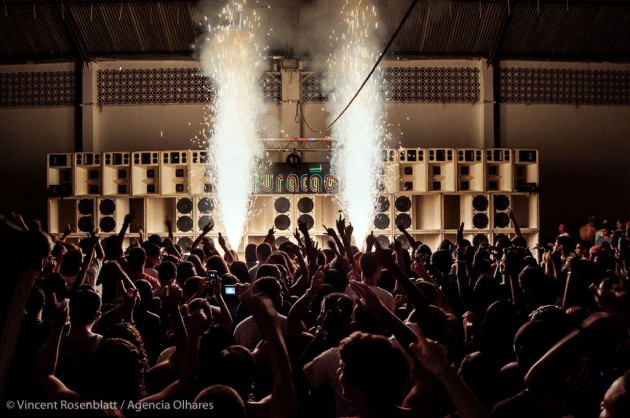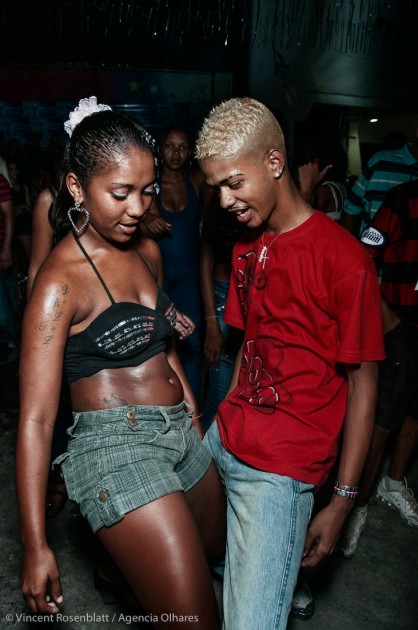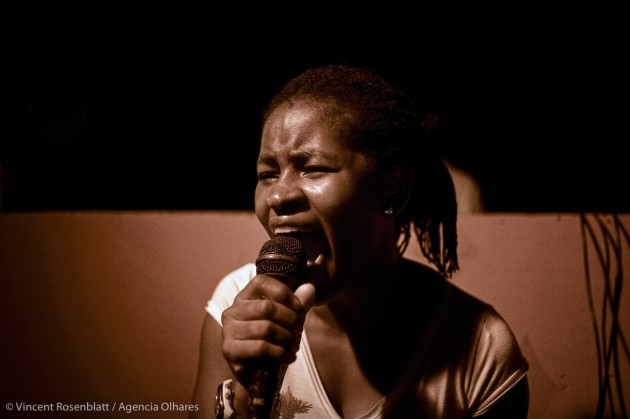
Funk Carioca: The Beat Goes On
17 June, 2014The history of funk carioca tells the story of Rio’s favelas and their place in the city. It’s a story of creativity, oppression and resistance. Although those from outside as well as inside the favelas criticize its current incarnation for being vulgar, cheap and commercial, there’s a lot more to it than that.
From Miami Funk to Favela Funk
The music that is known as ‘funk’ in Brazil doesn’t have much to do with the music we call ‘funk’ in the rest of the world. Funk carioca (literally ‘funk from Rio’) was born in the late 70s, when Brazilian DJs went to America to buy ‘black music’. Originally, they bought mainly black American funk, but when they started to import freestyle, hip-hop and other genres, the term ‘funk’ remained.
Brazil’s favelas arose in the late nineteenth century when labourers from the countryside came to the city in search for a better life. Over the years, the favelas grew exponentially and, even now, a migration of labourers, mainly from the poorer north-east, is still going on. The result: gigantic neighbourhoods without any spatial planning. It was in these favelas in the 80s that funk carioca became extremely popular.
From Favela Funk to Funk Carioca
Until the mid-80s, the people from ‘o asfalto’ (term used to describe all city dwellers who don’t live in a favela) simply didn’t know that something such as funk carioca existed. Due to the strong connotation of the favela with violence and drugs, people from outside the favela rarely dared (and still rarely dare) to enter those neighborhoods. However, funk proved itself strong enough to cross this psychological boundary, starting with radio and television broadcasts about funk which soon became popular among many cariocas (inhabitants of Rio).
Electronic Drums, Traditional Rhythms and Beatboxing
Brazilian funk music consists, with a strong influence from American hip-hop, of a DJ and an MC (either rapping or singing), sometimes accompanied by live drums and a group of dancers.
In the early years of the funk, DJs used loops of electronic drums from Miami bass. In 1998, DJ Luciano Oliveira caused a revolution in the funk by combining the rhythms and drums from capoeira (a Brazilian martial art), Maculelê (an Afro-Brazilian dance with sticks) and Candomblé (a religious dance) with rhythms from Miami bass and North American rap. This resulted in the so-called ‘Tamborzão’ rhythm. Tamborzão dominated the funk until 2010, when human beat-boxing made its entrance, though it has remained extremely popular. Funk was born and has developed itself in a typically Brazilian way, integrating musical and cultural elements from everywhere, but evolving in a very personal way.
The Voice of Afro-Brazilian Identity
In its early years, funk spoke about poverty, human dignity, racial pride, sex (breaking moral taboos), violence and social inequality. Mano Teko, president of APAFUNK, an organization that stands up for the rights of funkeiros (funk artists and fans) and whom fights against the ongoing discrimination of funk music and culture, explains: “Funk music was a statement of Afro-Brazilian identity, as well as a struggle for cultural rights. It was the only opportunity for the oppressed to raise their voice and sometimes it still is.”
An Ode to Violence or a Report of Reality?
In the 70s, drug trafficking began to flourish in the favelas. The daily ruling of the favela was in the hands of criminals and when police raided the favelas, it often resulted in a bloody battle between the two parties. From the 90s onwards, much of the funk carioca talked about this violence.
When these songs, that revealed and denounced the police violence, became popular in the rest of Rio, the municipality got scared. The city council judged that these songs were an ode to the drug-lords and to criminality, and forbade them. These numbers were henceforth called ‘proibidão’, literally ‘forbidden’ funk.
Many funkeiros find the banning of this funk style a form of censorship and deprivation of the right to free speech. Mano Teko explains: “The texts are not an ode to violence but simply a record of the daily reality in the favelas. Does a news reader not do the same? And does he get punished? The truth is that the municipality bans funk because they are afraid of its power. Funk is a form of protest, and in the favelas any form of protest is forbidden.”
Restrictions and Repression
The central happenings in funk-culture are the bailes funk, giant outdoor parties that in the 80s brought each week more than one million young people together, and that are still very popular. The sound system (‘equipe do som’) is the basis of the party: without a sound system, there is no baile funk. The sound systems are owned by traditional funk protagonists and families, like Furação, Pitbull, Chatubão Digital, Espião Vida Loka, Serie Gold and Cash Box. They ensure the music is blaring loud throughout the whole favela. At 2am a huge crowd will have gathered and people will dance for hours in a very sensual or explicitly sexual way. The young demographic of the favelas contributes to the popularity of the music and the format of the baile.

Due to the size of the bailes and the possibility that fights would break out, the police feared that they were breeding grounds for drug trafficking and violence. Henceforth the government decided to practically forbid them. In a law of May 2000, the government set a number of demands for these open air parties. From then onwards, in order to organize a baile, the police had to give permission. Furthermore, the police had to be present at the baile, there was a maximum of people allowed at the venue, and so forth. Later on, even more restrictions were imposed: the party had to end at midnight, and a lot of safety aspects and other requirements made the organization of a baile nearly impossible.

In Rio, this regime is ongoing. In the early 00s, around 500 bailes took place in Rio. Nowadays, there are no more bailes at all in all the ‘pacified’ favelas, and even outside of the favela it’s not easy to organize them. Only in a few of the unpacified favelas that are still not under the control of the police, can bailes take place in their original form.
Funk Melody
To counteract the violent lyrics and bad reputation that funk has acquired, some singers created songs in which they expressed their desire for peace in the favelas. MC Cidinho & Doca became famous with their single “Rap Da Felicidade” in 1995, singing about their life, love and happiness. The opening line “I only want to be happy, to walk peacefully in the favela where I was born” was applauded by a mass public.
In the meanwtime, many songs changed their focus from politics and violence to more romantic topics. This genre acquired the name ‘funk melody’. Some famous groups are Latino, Copacabana Beat, MC Marcinho, while DJ Marlboro was the one pushing this style forwards. However, some other funk artists blame this funk melody for selling the soul of the funk by focusing on a broader public.
The existing of this softer ‘funk melody’ is definitely one of the reasons why the assembly of Rio accepted funk officially as a ‘cultural movement’ in 2009. Meanwhile, proibidão was still banned and the many restrictions on the bailes funk have continued to exist.
Sexism and Feminism
Over the last few years, a new genre of funk arose, the ‘funk putaria’ (literally ‘fornication/prostitution funk’), characterized by its lyrics that speak almost exclusively about sex. Women are often described as putas (whores), cachorros (dogs) or popozudas (big butts). This style receives much criticism: the texts are claimed to be demeaning for women and extremely sexist. However, some feminists and funkeiras find that through funk, a young feminist movement has emerged. Amy Richards and Jennifer Baumgardner for example, two prominent feminists, explain that it’s not about words, but about who is in control of them: “For years, these words have been used against women. Now, by singing these songs themselves, the funk artists demonstrate that they are in control. This feminism is very difficult to understand from the point of view of the traditional European and American feminists, who for years fought for equality and against the image of women as sex objects. However, we must realize that the feminism back then was a ‘first world’ feminism, a white, literate and heterosexual concept. What happens here is different. These – often black women – fight for recognition of the difference between men and women and for the freedom of expressing their feminine sexuality as they want it.”
“’Yo, bro’! I’m young, hot, sexy and, yeah, I’m a bitch. You got a problem with that?’ This text of funk singer Deize Tigrona, summarizes for me [what] funk feminism is all about,” explains Kate Lyra, feminist, singer, author and associate researcher to funk in an article on riobailefunk.net.

The Business
In the past 5 years, funk has become a substantial industry in Brazil. Yet, even though the biggest and most famous artists can gain good money with it, there are still many who struggle to earn their bread with the music. Even when they get the chance to record their music in a studio, they don’t earn a lot. Mano Teko from APAFUNK explains that these “artists are often extremely talented young people from the favela who work hard. The record companies however give them extremely bad contracts and run away with the bulk of the money.”
As for the selling of records, there is very little potential for making money. Most music is distributed through the favelas and through Rio via illegal, home-made CD-R’s. Yet, ironically enough, the funk music also survives exactly because of that piracy: because of the low price of the records, the music spreads quickly, something that with a higher price would be impossible. The result is that artists are invited to performances, with which they do earn money. Based on the notoriety they acquire there, there is a chance that the artist will become known throughout Rio, Brazil or abroad.
International Coverage
In the last ten years, funk carioca has become more and more known throughout America and Europe. In 2001, the first funk songs could be heard abroad, thanks to the album Favela Chick from BMG. Also M.I.A. brought international popularity to Brazilian funk with her single “Bucky Done Gun” in 2005. Conversely, funk started integrating melodies of foreign songs, such as Eric Clapton’s “Layla”, Gerry Rafferty’s “Baker Street” and “Set Fire to the Rain” by Adele.
Criticized But Popular
The current funk carioca is often criticized. Within the favela, people feel sorry that their once so beloved funk turned into ‘vulgarity and pornography’. Outside of the favela, a lot of people find the funk violent, sexist, cheap and superficial. DJ Marlboro sees a reason for that: “Funk is often used by the middle class to unload their prejudice against the lower classes. They denounce funk, without even knowing it.” That there is a high probability of truth in his claim can be deduced from the broader context: most of the people from o asfalto still haven’t set one single step in this often most colourful and liveliest of neighbourhood. The overall image they have of the favela is one of violence and poverty, an image too distorted and too simple to be real.
Moreover, despite this criticism, nearly all cariocas know the most recent funk hits. During “alternative” parties, the songs get remixed for the middle class, sometimes leaving the most ‘sexist’ lyrics blank. And although a lot of them denounce the funk as cheap, commercial and vulgar, it’s often this favela-bred music that really gets their party on fire.
All photos by Vincent Rosenblatt. To see more of Vincent’s work go to vincentrosenblatt.com and riobailefunk.net
More Information
Some currently popular funk artists:
MC Britney
MC Magrinho
MC Nego do Borel
Bonde das Maravilhas
MC Pocahontas
DJ’s
DJ Marlboro
DJ Amazing Clay
DJ Grandmaster Rafael
Well-known female/feminist artists
Deize Tigrona
Tati Quebra Barraco
Valesca Popozuda
MC Sabrina
Funk Melody
Latino
Marcinho
Copacabana Beat
Proibidão / Antigos
Menor do Chapa
Mr Catra
Duda do Borel
Cidinho & Doca
MC Orelha
Lexicon Of Funk
Funk carioca: literally ‘funk from Rio’, a unique musical style born in Rio’s favelas in the 70s/80s. Also known as ‘favela funk’, ‘Brazilian funk’, or ‘baile funk’.
O asfalto: term used to describe city dwellers who don’t live in a favela
MC: ‘Master of Ceremony’; term originally used in hip-hop but also used in funk carioca
Miami bass: type of hip-hop which was popular in the 80s-90s, known for its use of the Roland TR-808-drum, a high dance rhythm and its often explicitly sexual lyrics
Funkeiros: each funk artist and fan of funk music
Proibidão: literally ‘the forbidden’. The funk sub-genre which lyrics talk about violence and which is currently forbidden
Baile funk: gigantic funk parties that find place in Rio’s favelas
Equipe do som: sound system, very important in the bailes funk
Pacified: pacification is a program set up by the government of Rio in 2007 for police to re-conquer control over the city’s favelas where for decades drug gangs were ruling the area. However, there is a lot of criticism on the violent way this ‘pacification’ is happening.
Funk melody: the funk genre that, as a reaction to the funk proibidão, changed its focus from politics and violence to more romantic topics. More melodies are integrated into the songs.
Funk putaria: literally ‘prostitution funk’. The funk sub-genre which talks exclusively about sex, often in very explicit and brutal terms.
Sources
Interview with MC Leonardo, 13/03/2013
Interview with Mano Teko, president APAFUNK, 13/03/2013
Interviews with Vincent Rosenblatt, photographer and specialist in funk music/culture.
xlr8r.com/features/2005/05/funk-phenomenon
riobailefunk.blogspot.com.br
riobailefunk.net
proibidao.org
academia.edu/2547984/_Proibidao_em_tempo_de_pacificacao_armada_
Follow Sounds and Colours: Facebook / Twitter / Instagram / Mixcloud / Soundcloud / Bandcamp
Subscribe to the Sounds and Colours Newsletter for regular updates, news and competitions bringing the best of Latin American culture direct to your Inbox.

